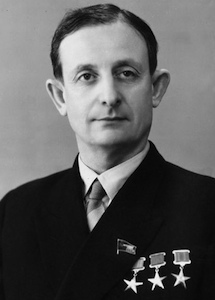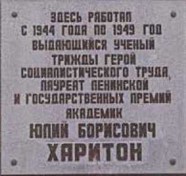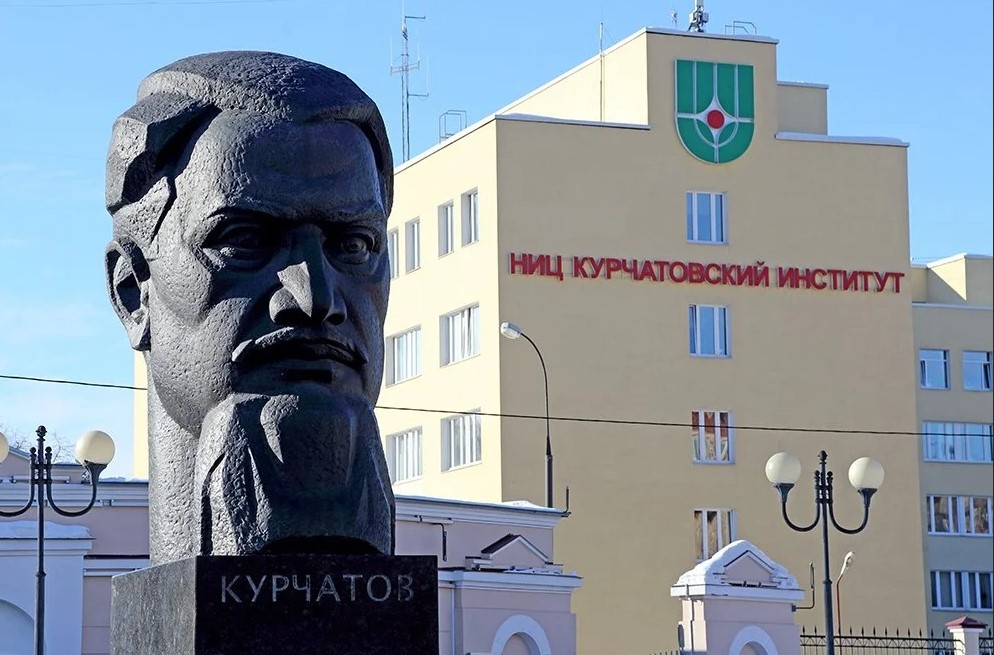Yuli Borisovich
Khariton
1904-1996

Yuli Borisovich Khariton was a Soviet and Russian theoretical physicist and physicochemist, Doctor of Physical and Mathematical Sciences, Academician of the USSR Academy of Sciences and RAS, Three times Hero of Socialist Labor. In 1919, after graduating from college, he tried to enter the Institute of Technology, but was not accepted due to his youth. In 1920 he became a student of Polytechnic Institute – first of the Faculty of Electromechanics, and since the spring of 1921 – of Physics and Mechanics. In the same year, 1921, he was invited by N.N. Semenov (in the future twice Hero of Socialist Labor and winner of the Nobel Prize in Chemistry – the only one in Russia) to work in his laboratory at the Institute of Physics and Technology. Here, in 1924, the first scientific work of Khariton was published, devoted to the study of condensation of metal vapors on the surface. In 1925-1926 he studied the oxidation of phosphorus vapors with oxygen and discovered (together with Z.F. Valta) the phenomenon of the lower limit on oxygen pressure and the influence of inert gas impurities on this limit. In 1927 he conducted with N.N. Semenov detailed study of the ignition limit and the first theoretical justification of its mechanism served as the basis for the theory of branched chain reactions. In 1926, with the support of A.F. Ioffe, P.L. Kapitsa and N.N. Semenov, Khariton was sent to England, to the laboratory of Ernest Rutherford, where he studied the sensitivity of the eye to weak light pulses (scintillations) and the interaction of gamma radiation with matter, as well as the development of a technique for registering alpha particles. In 1939-1941 Khariton studied the chain fission of uranium and together with Ya.B. Zeldovich performed one of the first calculations of the nuclear chain reaction, which became the foundation of modern reactor physics and nuclear power. During the Great Patriotic War, the scientist and his staff were seconded to the Research Institute-6 of the People’s Commissariat of Ammunition of the USSR (1942-1944), where they carried out a series of works to improve the efficiency of various designs of ammunition and explosives and the study of the air shock wave. Applying the results obtained in practice, Khariton took an active part in the creation of cumulative anti-tank grenades and shells that were successfully used on the fronts. In 1935 according to the totality of his merits, he was awarded the degree of Doctor of Physical and Mathematical Sciences. Since 1944 he was a consultant, since 1945 he was a full–time employee of Laboratory No. 2 of the USSR Academy of Sciences under the leadership of I.V. Kurchatov. In 1946, in the south of the Gorky (now Nizhny Novgorod) region, the center for the development of nuclear charges was founded – Design Bureau No. 11 (KB–11, now the All-Russian Research Institute of Experimental Physics (VNIIEF; now the Russian Federal Nuclear Center – the All-Russian Research Institute of Experimental Physics) in the city of Arzamas–16 (in 1991-1995 – Kremlev, since 1995 – Sarov). Yuli Borisovich Khariton (1946-1992) became its chief designer, and since 1952 scientific supervisor on the recommendation of I.V. Kurchatov. The best physicists of the country were involved in the work on the implementation of the nuclear weapons program: Ya.B. Zeldovich, A.D. Sakharov, I.E. Tamm, K.I. Shchelkin, G.N. Fleerov, N.N. Bogomolov, E.K. Zavoysky, M.A. Lavrentiev, D.A. Frank-Kamenetsky and others, as well as mathematicians M.V. Keldysh, I.M. Gelfand, A.N. Tikhonov. Here, in an atmosphere of the strictest secrecy, work was carried out to eliminate the American nuclear monopoly as soon as possible, culminating in the testing of Soviet atomic (1949) and hydrogen (1953) bombs. For his outstanding achievements, Yulia Borisovich Khariton was awarded the title of the Hero of Socialist Labor three times.
Address: Moscow, Akademika Kurchatov pl., 1, p. 1

